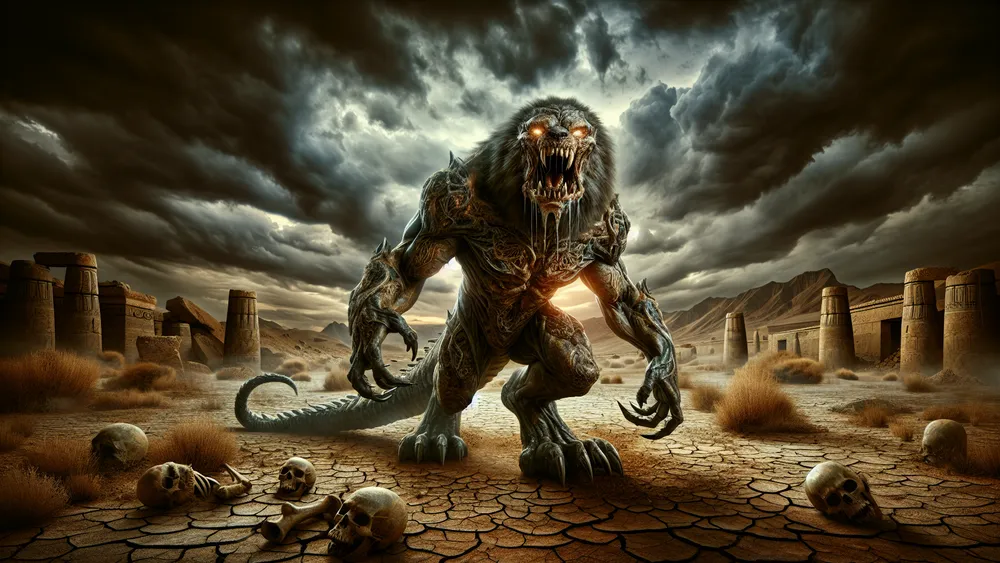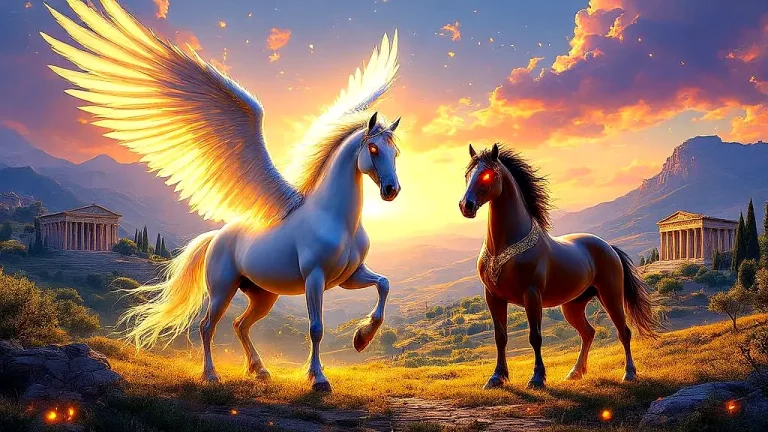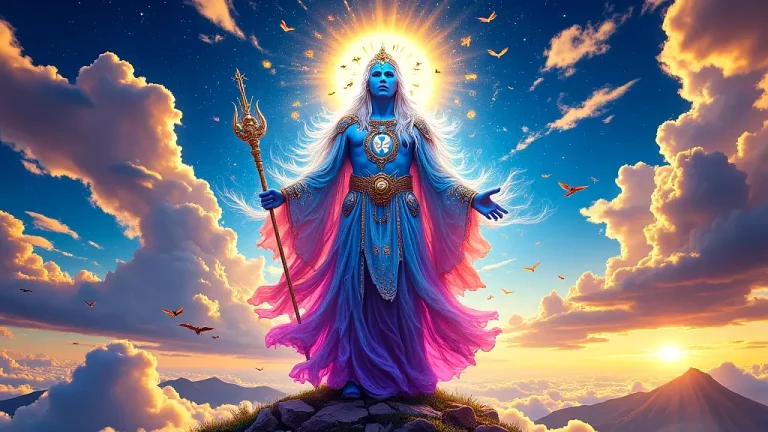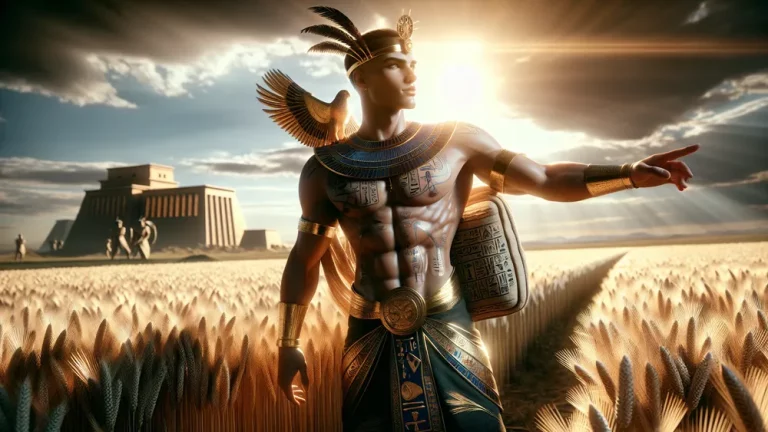Am-Heh: The Devourer Of Millions In Egyptian Mythology
Welcome to the interesting world of Egyptian stories, where gods and goddesses have a lot of power and influence over the whole universe and life after death. In this blog post, we will look into the puzzler character of Am-Heh, called the “Devourer of Millions.” Think of a protector in the underworld, a scary being with a dog’s head, whose name alone can cause fear in those who hear it.
Key Points:
- Am-Heh is the Devourer of Millions in Egyptian mythology, a fearsome deity in the underworld.
- He is linked to the Lake of Fire, where he enforces divine justice and punishes unworthy souls.
- Am-Heh is represented with a dog-headed appearance, symbolizing his role as a soul eater.
- His job involves guarding the Lake of Fire and maintaining balance in the afterlife.
- Am-Heh works alongside gods like Osiris, Anubis, and Ammit in the judgment and cleansing of souls.
- Depictions of Am-Heh in ancient Egyptian art emphasize his scary presence and role in the underworld.
- Am-Heh’s significance lies in his impact on Egyptian myths, emphasizing moral judgment and consequences in the afterlife.
Am-Heh is not as well known as some other Egyptian gods, but his role is still important. He is an important character in life after death, linked with the Lake of Fire, which is a place for judging and cleaning souls. During this post, we will see who Am-Heh is, where he came from, his scary look, and his key role in life after death.
Also, we will check how he works with other gods, how he is shown in art and old texts, and his lasting effect on stories. Whether you are an experienced mythology fan or just curious, this trip into Egyptian mythology will be both teaching and interesting.
Am-heh: Overview and Key Facts
| Main Point | Information |
|---|---|
| Name | Am-Heh |
| Meaning of Name | “Devourer of Millions” |
| Role in Stories | Guard of the Fire Lake, connected with the life after death |
| Look | Dog-headed shape, often shown with a fierce, scary look |
| Meaning | Shows the breaking and cleaning sides of the afterlife |
| Link to Other Gods | Linked with Osiris, Anubis, and Ammit in the space below the world |
| Images in Art | Rarely pictured, but when it is, points to his scary, strong self |
| Texts That Talk About Him | Named in many old Egyptian papers, showing his part in the life after death |
| Effect on Culture | Changed later stories and gods, lasting mark in Egyptian stories |
Getting to Know Am-Heh in Egyptian Myths
To really grasp Am-Heh’s place in Egyptian stories, we need to dig deeper into his identity, beginnings, and the special features that make him different from other gods. First, let’s check out who Am-Heh is, and what makes him such a daunting figure.
Who’s Am-Heh?
Am-Heh is a less-known but strong god in Egyptian stories, usually called the “Devourer of Millions.” His main job is linked with the underworld, where he works as a guard and enforcer of divine rules. Differently from more kind gods, Am-Heh shows the darker sides of life after death, making sure wicked souls are punished. His scary name, which means his never-ending hunger for eating endless souls, shows his tough reputation.
This title, “Devourer of Millions,” points to his job as a never-stopping force of ruin and cleaning in the next life.
Am-Heh is tied to the Lake of Fire in the underworld, which is a place of pain and cleaning for souls seen as not good enough. His link with this burning lake shows his role as a bringer of divine payback. To say it simply, if the next life were a court, Am-Heh would be like the executioner, making sure justice happens without mercy. His presence in the underworld always reminds us of the results of moral and ethical wrongdoings. Some main parts of Am-Heh’s job include:
- Guardian of the Lake of Fire: Watching over the place of pain and cleaning.
- Enforcer of Divine Rules: Making sure the bad souls get punished.
- Symbol of Ruin and Cleaning: Showing the darker parts of life after death.
By knowing these parts of Am-Heh, we get a clearer view of his importance in Egyptian stories and the next life.
Am-Heh plays a crucial role in Egyptian mythology as the enforcer of divine justice in the underworld, punishing wicked souls and symbolizing the consequences of moral wrongdoings.
Where Did Am-Heh Come From?
The beginnings of Am-Heh are wrapped in the mix of Egyptian creation stories, blending history and made-up tales. Unlike big gods like Ra or Osiris, Am-Heh does not have a well-known start story. Instead, he comes from the darker bits of Egyptian world views, showing the wild and ruining parts that balance the orderly world kept by other gods.
His being is often implied rather than clearly stated, suggesting he is an old force rather than a god with a clear start story. This makes Am-Heh different, as he shows the dangers and hard times of the next life, rather than being a maker or a leader.

Am-Heh’s place in old Egyptian writings and beliefs is rare but important. He is talked about in different funeral writings, like the Coffin Texts and the Book of the Dead, where he is shown as a scary guard of the underworld. These texts show his job in the next life, focusing on his task to eat the souls of those seen as not good enough. Unlike other gods who have big stories about their starts and deeds, Am-Heh’s story is more broken, showing his role as an enforcer of divine rules rather than a big name in start stories. Important points about Am-Heh’s beginnings include:
- Very Old Force: Shows wild and ruining parts of the world.
- Rare Talks: Found in different funeral writings, focusing on his job in the next life.
- Different Role: Unlike other gods, he is more of a rule enforcer than a maker or leader.
By knowing these points of Am-Heh’s beginnings, we can see his different spot in Egyptian stories and the special job he has in the balance of order and wildness.
What Am-Heh Looks Like and Means
Now that we have looked into Am-Heh’s beginnings and his role in Egyptian stories, let’s see what he looks like and the meaning behind it.
Am-Heh’s Scary Dog Head
Shown with the head of a mean dog, Am-Heh looks different from other Egyptian gods right away. This dog head is not random at all; instead, it is filled with deep meaning. In old Egypt, the dog often meant protection, loyalty, and the afterlife. Although, for Am-Heh, the dog head seems more scary, showing his job as a soul eater.
His sharp teeth and mean look are meant to scare, showing visually what waits for those who do not live a good life. This scary look shows his role as a enforcer of divine justice in the underworld.
When looking at Am-Heh next to other gods with dog heads like Anubis and Ammit, the differences are clearer. For example, Anubis is shown with a dog head too but is seen mainly as a guide and soul protector, taking them safely to the afterlife. Ammit, however, has a more similar job to Am-Heh as she eats the unworthy, but she has a mixed look, with parts of a lion, hippo, and crocodile. Am-Heh, unlike Ammit, has just a dog look, focusing only on eating and destroying. Important points of difference are:
- Anubis: Dog-headed, protector and guide of souls.
- Ammit: Mixed form, eater of the unworthy.
- Am-Heh: Only dog-like, enforcer of divine rules by eating.
By seeing these visual and symbolic differences, we better understand the unique role that Am-Heh plays in the complex weave of Egyptian stories.
What Devouring Means
In old Egyptian times, the act of devouring held deep importance. It often meant purification and judgment, where devouring showed the eating and removal of bad or unworthy parts. This idea is deep in the Egyptian belief system, where the next life was seen as a place of judgment and change. The devourer acts as a cleaner, making sure only the good can go to the next life.
This meaning is clear in many mythological figures and rituals, where devouring is used as a way to clean the soul.
Am-Heh’s job as a devourer fits smoothly into this broader Egyptian mythology. As the “Devourer of Millions,” he shows the final enforcer of divine justice, eating the souls of those who do not meet the rules set by the gods. This act of devouring is not just an act of destruction but a needed process to keep cosmic balance and order. By removing the unworthy, Am-Heh keeps the next life pure. To understand this better, let’s compare Am-Heh’s devouring meaning with other gods known for similar roles:

| Deity | Role in Devouring | Symbolism |
|---|---|---|
| Am-Heh | Devourer of souls | Purification, divine justice |
| Ammit | Devourer of hearts | Judgment, balance of Ma’at |
| Sekhmet | Devourer of enemies | Destruction, protection, healing |
By seeing this table, we can see that while Am-Heh, Ammit, and Sekhmet all share the act of devouring, each god’s role and meaning are different yet connected in the larger framework of Egyptian beliefs.
What Am-Heh Does in the Afterlife
As we have talked about the meaning of devouring, now let us look at Am-Heh’s main jobs and the things he does in the afterlife.
Watching Over the Lake of Fire
Am-Heh’s job as the watcher of the Lake of Fire is an important part of his work in the underworld. The Lake of Fire shows a fiery, rough body of water where bad souls are sent for cleaning or destruction.

As its watcher, Am-Heh stands guard over this scary place, making sure only those truly worthy of such a fate go into its depths. His presence at the Lake of Fire is a warning to badness and a reminder of the hard results of breaking moral and ethical rules.
By guarding this lake, Am-Heh keeps the balance of justice in the afterlife. The importance of the Lake of Fire in the afterlife is big. It shows the final type of divine payback and cleaning, where souls are either cleaned of their sins or totally destroyed. This idea is somewhat like modern thoughts of purgatory, where souls go through cleaning before they can enter a state of eternal peace.
Am-Heh deals with the souls that come before him by looking at their deeds and deciding their worth. Those who are found wanting go into the Lake of Fire, where they face the results of their earthly actions. This dealing shows the need for living a good life, as the judgment of Am-Heh is both final and absolute.
Am-Heh’s role as the guardian of the Lake of Fire is crucial for maintaining justice in the afterlife by determining the fate of souls based on their actions.
How Am-Heh Gets Along with Other Gods
Am-Heh’s connection with Osiris, the god of the afterlife, is both about following orders and working together. Osiris, who is the head of the underworld, leads the judgment and fate of souls, but Am-Heh acts as the person who carries out this divine justice.
Their jobs fit well together; Osiris leads the weighing of the heart ceremony, where the dead person’s heart is measured against the feather of Ma’at, the goddess of truth and justice. If a soul is seen as unworthy, it is Am-Heh who makes sure that the soul faces the right consequences. Often, this involves the Lake of Fire.
This setup shows a well-organized system of justice in the afterlife, where each god has a specific job that adds to the overall process of judgment and cleaning. Along with his connection with Osiris, Am-Heh also works with other gods like Anubis and Ammit. Anubis, the jackal-headed god, mainly leads souls through the underworld and handles the embalming process.
Anubis is more of a guide and protector, while Am-Heh deals with the souls that fail the afterlife tests. Ammit, called the “Devourer of the Dead,” has a similar job to Am-Heh in that she eats the hearts of the unworthy. However, while Ammit is shown as a mixed creature, Am-Heh’s pure canine form shows his single focus on devouring.
These interactions show a combined effort among the gods to keep cosmic order and justice, with each god or goddess having a clear but connected role in the complex picture of the Egyptian underworld.
How Am-Heh Shows Up in Art and Stories
Since we’ve looked at Am-Heh’s connections with other gods, now let’s look into how he is shown in ancient Egyptian art and writings.
Am-Heh in Egyptian Art
In old Egyptian art, Am-Heh is usually shown with a fierce dog-headed shape. Often, he has a scary look to strongly show his job as a soul eater. This dog look is not just randomly picked. It stands for his fierceness and his job as a watcher of the Lake of Fire.
The dog head is a regular theme in Egyptian stories. This is often seen with gods tied to the afterlife, like Anubis. But, not like Anubis, who is shown as a guide and protector, Am-Heh’s look is scarier. It shows his punishments in the underworld. These pictures remind the living.
They show the hard results of bad actions and the need to live a good life.
These pictures matter because they show complex religious and moral ideas in a simple way. Showing Am-Heh with a so scary look, old artists in Egypt could tell his role and how serious his jobs are in the afterlife. The images were not just for decoration. They were a big part of the religious and cultural life in old Egypt. They served as warnings and reminders of the moral rules in the afterlife. Some well-known things and artworks with Am-Heh include carvings in temples, texts for funerals, and small charms. Here are some main examples:
- Temple Carvings: Pictures in some temples show Am-Heh in scenes of judgment and punishment.
- Funerary Texts: Books, like the Book of the Dead, have pictures of Am-Heh in the underworld.
- Amulets: Small charms that show Am-Heh’s look were used to keep away bad things and ensure safety in the afterlife.
Am-Heh in Old Texts
Mentions of Am-Heh in old Egyptian writings are pretty few but big. One main source to mention Am-Heh is the “Book of the Dead”, a set of texts meant to help dead people in the afterlife. In these writings, Am-Heh is often shown as a scary being connected to the Lake of Fire, showing his job in the judgment and punishment of souls.
Another key text is the “Book of Gates”, talking about the travels of the sun god Ra through the land of the dead. Am-Heh here is shown as one of many watchers making sure only the good souls can go through different gates in the underworld. These mentions show the importance of Am-Heh in the larger picture of Egyptian ideas on death and moral order in the afterlife.

The importance of these writings lies in the way they give clues into the old Egyptian view of the world and their thoughts about life after death. By adding Am-Heh in these texts, the old Egyptians stressed the need for moral goodness and the results of not living a good life. These writings worked not just as faith guides but also as moral signs warning people of the forever results of their deeds. Important texts showing Am-Heh include:
- Book of the Dead: A set of spells and chants made to guide dead people through the afterlife.
- Book of Gates: Tells about the travels of the sun god Ra through the underworld, showing many watchers, including Am-Heh.
- Pyramid Texts: Some of the oldest holy writings in Egypt, carved on pyramid walls, sometimes mentioning gods like Am-Heh in the afterlife setting.
Altogether, these texts help us know about Am-Heh’s job and the bigger religious and moral ideas in old Egyptian life.
How Am-Heh Made an Impact
After looking at how Am-Heh was shown in art and old writings, now we should look at the bigger effect he had on other gods, stories, and today’s views.
How Am-Heh Affected Other Gods and Myths
Am-Heh’s role, being called the “Devourer of Millions”, had a big effect on how later gods and stories in Egyptian myths grew. His link to the Lake of Fire and punishment of souls set a path for other gods who dealt with judgment and afterlife works. For example, Ammit, the demon lady who ate hearts of the guilty, has a similar role of punishment.
Ammit takes part directly in the heart weighing ceremony, however, Am-Heh’s wider role as eating many souls shows the strong fear of moral payback after death. This is clear in how later stories and gods kept showing the effects of bad morals and the need for a good life. Am-Heh’s effect on Egyptian myths is deep, mostly about afterlife and moral judgment.
He made the myths stress that after life was both rewarding and punishing, based on one’s actions when alive. This good and bad theme is found often in Egyptian stories, where gods like Osiris and Anubis also play big parts in the afterlife.
But, Osiris, seen usually as a kind judge, or Anubis, who leads souls, Am-Heh’s role is scarier, reminding of bad moral breaks. Comparing his effect to other main gods shows that while each had unique jobs, Am-Heh’s role was to stand for the scary part of divine payback, shaping the moral and religious scene of old Egyptian society.
What People Today Think of Am-Heh
Today, Am-Heh is often seen as a sign of godly payback and the darker parts of the afterlife. His scary job as the “Devourer of Millions” connects with today’s people who find themes of judgment and punishment interesting.
In books, Am-Heh sometimes shows up in works that look into old Egyptian myths, reminding us of the moral results that were very important in the old worldview.
For example, in today’s books and stories talking about Egyptian myths, Am-Heh’s role is often used to show the seriousness of the afterlife’s moral judgments, much like how the Grim Reaper is used in Western stories to stand for death and the certainty of destiny. Am-Heh’s picture in art and movies also shows his lasting name.
Artists and filmmakers often show him with his special dog-headed look, stressing his scary presence and job as a guard of the underworld. This image makes people feel fear and respect for the ancient thoughts about the afterlife. In today’s myths, Am-Heh is still a strong sign of the results of moral wrongs, like other myth figures who stand for punishment and payback.
His name stays as a reminder of the old Egyptian focus on being morally good and the belief that what you do in life has forever effects. This lasting place in today’s culture shows how these themes are timeless and how myth figures from long ago are still important when looking at human morality.
Egyptian Mythology Creatures
Egyptian myths have a group of gods and goddesses and also creatures, each having their own special jobs. For a complete look at these interesting creatures, you can check this list of all the Egyptian creatures, which gives detailed descriptions and insights into their importance and stories.
FAQs
1. Who is Am-Heh in Egyptian mythology?
Am-Heh in Egyptian mythology is a fearsome deity known as the “Devourer of Millions” who resides in the underworld.
2. What does Am-Heh symbolize?
Am-Heh symbolizes the destructive and devouring aspects of the afterlife in Egyptian mythology.
3. How is Am-Heh depicted in ancient Egyptian art?
Am-Heh is depicted in ancient Egyptian art as a fierce, dog-headed deity often associated with the underworld.
4. What is the significance of the Lake of Fire in the afterlife?
The significance of the Lake of Fire in the afterlife lies in its role as a place of purification and punishment for souls deemed unworthy.






